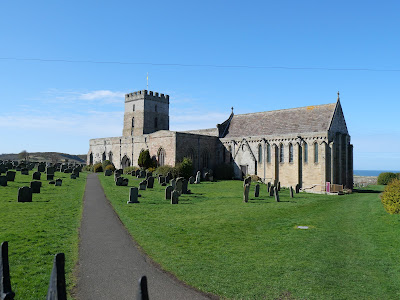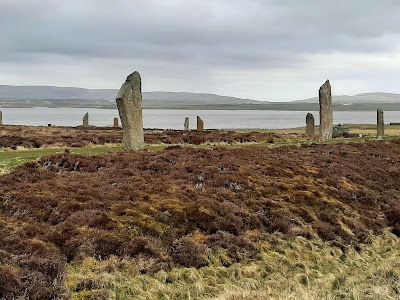In the Borders it is customary for visitors to view its magnificent Abbeys--Kelso, Melrose, Dryburgh and Jedburgh. And they are impressive. But there is also another layer of faith, if you will, throughout the
Borders that is represented by the local church, or kirk. The local
parish.
 |
April 2, 2023: St. Aidan's Church, Bamburgh
|
Take for example, St. Aidan's Church at Bamburgh, the Anglo-Saxon seat of
power where Northumbrian kings are said to have been crowned. The story of St. Aidan merits a few comments.
 |
April 2, 2023: Interior of St. Aidan's Church
|
In translation, Aedán, or Aodhán, means "little fiery one". An Irish missionary, Aidan is credited with converting the Anglo-Saxons to Christianity--preaching to both nobility and slave.
More is known about Aidan's death (August 31, 651) than about his early years (born about 590). He essentially enters history's pages from the Holy Isle of Iona (which was established by St. Columba about 563 AD).
A
bishop named Cormán was originally dispatched to the Scots, but his harsh methods at conversion left much to be desired. [In deference to Cormán, it must be said that he had a significant impact on evangelizing the
people of Northumbria. He laid the groundwork in other words.]
In any case, Aidan was
sent from Iona in Cormán's stead and Aidan, not Cormán, is now considered the Apostle of Northumbria. Aidan went on to found the priory on the Holy Isle
of Lindisfarne with its access to the kings of Northumbria at Castle
Bamburgh...until the coming of the Vikings.
 |
April 2, 2023: Aidan's Tomb
|
Interestingly, Aidan was a social reformer, in front of his time. Bede's Ecclesiastical History of the English Nation (Book III: Chapter V) states: "whatsoever gifts of money he received from the rich, he either
distributed them, as has been said, to the use of the poor, or bestowed
them in ransoming such as had been wrongfully sold for slaves." He evangelized against slavery and bondage, apparently taking it as his mission.
Aidan's tomb is found in Bamburgh's church. But what exactly is entombed is disputed.
After his death, Aidan's body was first buried at Lindisfarne, in the abbey he helped found. Apparently, his remains were disturbed and broken up following the defeat of the ‘Irish’ faction at the Synod of Whitby in 664 AD, when Roman Catholicism became dominate at the expense of the Celtic Church. In the
11th century, Glastonbury monks supposedly also obtained relics of
Aidan--again partitioning his remains. In fact, various locations today
claim relics of his partitioned body. He was not, in a word, at rest.
 |
April 2, 2023: Aidan's Tomb at Bamburgh Church
|
In 2013, an elaborate tomb was built within Bamburgh's church. It was dedicated by the Archbishop of York, presumably to finally put what remained of Aidan's remains at rest...or to memorialize them anyhow. The tomb says: "Quies Aidani" (Aidan at Peace). A small window is inscribed: “Not far from here, Aidan first Bishop of Lindisfarne, fell asleep in Christ.”
 |
April 2, 2023: St. Aidan's Church, Bamburgh
|
 |
March 27, 2017: Holy Cross, Haltwhistle
|
One last comment regarding Aidan. He was esteemed by the Scots. Thus, local lore has it, in the border raids on Haltwhistle in the 1500s, the Holy Cross Church (dedicated to St. Aidan; dates 13th century) was unmolested whereas much of the town was burnt. At an even earlier date, the church was immune when William Wallace was marauding the countryside in 1297 and 1298...though that may have to do with the fact that it belonged to a royal Scottish abbey...and the king would be sore displeased if it was harmed.
Eden's Lawn, taken from the Celtic 'Llan Aidan,' is allegedly where Aidan ministered. Ultimately, Holy Cross Church sprang from there.
 |
March 27, 2017: Edens Lawn, Haltwhistle
|
Whether Aidan was the first to evangelize Northumbria is also debatable. Aidan and his monks
slowly restored Christianity to the Northumbrian countryside, so perhaps he should be considered more a revivalist in a way because, as far as is known, St. Ninian (himself a shadowy figure given a lack of written records) is to be credited with being Scotland's first saint.
 |
April 2, 2023: Stained glass, St. Adian's
|
It is said that in 397 AD Ninian, a Briton, began his ministry to
Scotland, predating St. Patrick by more than 30 years. Ninian
evangelized the southern Picts from his church at
Whithorn on Burrow Head, Galloway, where St. Ninian had a white-washed
stone church built; hence the name. According to archeologists, it has "an atmosphere of spiritual antiquity" to it.
Ninian was born about 360 AD, died and was
buried at Whithorn in Galloway at the age of 72 in 432 AD at the time
St. Patrick began his ministry. Here it is of interest that Patrick, in
an epistle to Coroticus in which he condemned Coroticus for slavery,
termed the Picts as "apostates"--meaning they had abandoned Christianity
at some point in the early fifth century before being called back to
the faith. St. Ninian's initial efforts apparently were somewhat
temporary.
Ninian is said to have
evangelized his way up west Scotland's coast, possibly as far north as
the Shetlands. However, Christianity at Whithorn was older than Ninian. How much older is unknown, but it is probable that his appointment
as bishop was in response to an organized local British community that was already established as a center of trade and power, within the sphere of Roman Carlisle.
 |
April 2, 2023: Veteran's memorial at Bamburgh Castle
|
In the statement of significance (Historic Environment Scotland), Whithorn is "rightly styled" as the Cradle of Christianity
in Scotland and Northumbria--a veritable school for saints at the
beginning of evangelization. Archeologists have identified the remains
of a Christian community at Whithorn, as well as a monument (the Latinus Stone--oldest
known Christian memorial in Scotland) dating to the mid-5th century. In
its earliest days before Whithorn was a priory, it apparently was a
Christian site of some sort. It has been suggested that it could have
been a ceremonial meeting place for feasts, as archeologists found rare
imported wine, exotic herbs and spices
from Loire, France and numerous shards of fine colored glass
drinking vessels, suggesting a Romanized Briton Christian secular
settlement before Rome abandoned Britain in about 420 AD.
 |
April 2, 2023: Weathered gravestone, St. Aidan's churchyard
|
Whithorn is on our visit wish list. It has drawn many pilgrims through time, including King James IV of Scotland who annually visited the shrine until his death at Flodden Field; but also Robert Bruce (1329--to cure his leprosy), James V and Mary Queen of Scots (1563). Today it is a part of the Whithorn Way, a 143 mile pilgrimage trail from Glasgow Cathedral to Whithorn. Since at least the 600s...and counting...it has been a site of pilgrimage. It is old.
 |
April 2. 2023: St. Aidan's
|
St. Ninian's shrine at Whithorn and St. Aiden's in Bamburgh are only two examples of the many layers of faith that can be found in Scotland. You need not look far. It is ever-present. It is, in its way, the principle reason we continue to go back.
 |
April 2, 2023: Bamburgh Castle, Northumbria
|

.jpg)

.jpg)













